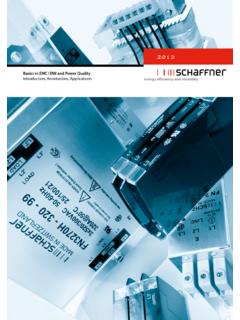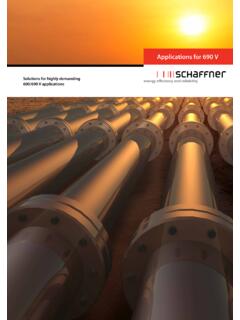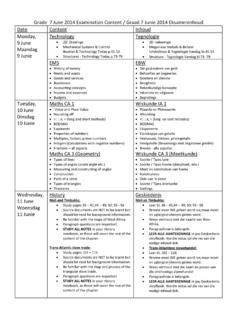Transcription of Application Note Sine wave filter solutions for motor ...
1 1 Sine wave filter solutions for motor drive applicationsApplication Note21. Technical background 32. motor drives output phenomena 4 Excessive dv/dt 4 Peak- and overvoltage 5 Additional losses in the motor 6 Cable shields and parasitic earth currents 6 HF electromagnetic noise in the motor cable 7 Bearing currents 8 Acoustic motor noise 93. Output filter solutions for motor drives 10 dv/dt reactor 10 dv/dt filter 11 Sine wave filter Symmetrical sine wave filter Sinus plus symmetrical and asymmetrical sine wave filter 144. Sine wave filter selection 16 Current and voltage rating 16 Frequency 17 Required drives settings 18 Voltage drop considerations 205. Application examples 21 motor drive with long motor cable 21 motor drive with multiple motors in parallel 21 Retrofit installations with motor drives 21 LV motor drive with MV- motor / 22 step-down / step-up transformer Application 6.
2 Mounting and installation guidelines 22 Important safety considerations 22 General Application notes 23 General installation notes 24 Mechanical mounting 25 Wiring and cabling 25 ContentNote: This document is in tended to support designers, installers, and Application engineers with sine wave filter selection, installation, Application and maintenance in motor drives order to get the maximum benefit out of the Schaffner filters, please also consult Basics in EMC and Power Quality , published in the download section of additional guidelines provide helpful hints for HF grounding, shielding, prop er cable routing including a chapter Output solutions for motor drives .Schaffner will not assume liability for any consequential downtimes or damages resulting from use or appli cation of this document and/ or installation of Schaffners or any other sine wave Technical backgroundWhenever electricity is used to drive an equipment, in particular when a motor drive is controlling the speed of an electric motor special attention of the noises generated by the motor drives need to be taken into consid-erations along the entire electric power line from the source to the guideline is intended to describe why and when to use which type of motor drive output filter .
3 Nevertheless, following overall view of the noise potential around the motor drive , which can cause equipment to malfunc-tion or be damaged, is shown as follow:Overview of noise potential around a motor driveFor cancellation of the unwanted noises and fulfilment of the norms on the line side, Schaffner offers a complete range of EMC filter and harmonic filter solutions for any applications , enabling cost effective standard and customized solutions to cancel or reduce the voltage and current noises to the levels 3-Phase motor drive applications , following filter combinations are ap-propriate to be considered:In this Application and selection guide the output filters and in particular the sine wave filters will be described in drives (frequency inverters) are among the most widely used pieces of equipment for AC motor control. Nowadays, they are found in virtually every area of industry, in applications as diverse as pumps, air conditioning systems, elevators and cranes, conveyors, machine tools, renewable elec-tricity production and in a vast array of other industrial and domestic auto-mation.
4 In the quest for ultra-compact, efficient power conversion, motor drive manufacturers employ high-speed semiconductor (IGBT ) switches and pulse width modulation (PWM) techniques to generate fast rise time voltage pulses of the appropriate duration and polarity. Unfortunately, this creates a considerable number of problems for OEMs and system integra-tors, from purely functional difficulties to very severe motor damage. Here is a brief summary of the most significant problems and phenomena: motor drive input: motor drive output: EMC problems Excessive dv/dt Harmonics Peak and overvoltage Commutation notches Parasitic earth currents Inrush & peak currents Eddy current losses in the motor Low-frequency interference Displacement currents in the coilsMotor drive DC link: Bearing currents DC link capacitor stress Additional inverter pulse loads Harmonics Acoustic motor noise Other interference problems EMC problemsWhole system: Low efficiency/low power factor Uncertain system immunity Unacceptable interference emissions Uncertain service security & reliabilityMotor drives are known sources of interference and are therefore usually equipped with an input filter .
5 However, the problems generated on the output side of the motor drives where the converter supplies the motor with a modulated rectangular PWM signal (a switching frequency depen-dent series of trapezoidal pulses with variable width) have to be taken into additional consideration as described in following Excessive dv/dt voltageTo keep the losses in the frequency converter low, the aim is to keep the switching times of the power semiconductors as short as possible. The re-sult of this is that with the newest generation of IGBTs, rise times of some-times more than 12 kV/us can be measured, whereas depending on the motor a dv/dt of around 1000 V/us is considered permissible. The IEC 60034-17 standard does define the voltage peak limits in relation to the rise 2. motor drives output phenomena/influence5time for general purpose 500 VAC motors when fed by motor drives and IEC 60034-25 specifies the limits for motor drive rated 500 VAC and 690 VAC motors.
6 For US applications the NEMA MG1 standard shows the limit for definite purpose motor drive fed of dv / dt: PWM-Signal and single pulse at the inverter outputIn the case of short motor cables (up to about 20 m), these rise times ow-ing to the small line impedance act fully on the insulation of the motor windings. Depending on the structure of the motor coils, wires that carry the full voltage are situated immediately in parallel and next to each other. Since even very short parallel-laid wires have a capacitive action, the per-manent potential jumps result in pole reversal losses across the winding insulation. Now, if the enamel insulation is impure even to a very minor extent, this results in hot-spots, and hence, sooner or later, to a destruction of the winding insulation. In any case, this dv/dt stress leads to prematureaging and thus to a reduction in the life of the motor , in particular when an older motor is fed by a motor Peak and overvoltageVoltage overshoots and voltage peaks can come with high dv /dt values but are also a problem on their own.
7 Due to the structure of the windings, a motor acts like a capacitor in the equivalent circuit diagram owing to the fast voltage pulses of the switching frequency and not as an inductance, as is the case in normal 50 Hz applications . With every additional meter of motor cable, more wire inductance is added to this structure. This induc-tance acts like a choke according to the energy storage principle. If chokes are subject to voltage pulses, voltage peaks occur every time switching on or off takes place. The higher the energy content (inductance) of the choke, the higher these voltage peaks become. In other words, the longer the motor cable, the higher the maximum voltage amplitudes. Simplified equivalent circuit diagram of shielded cables (only 2 phases are shown) and theoretical single pulse at 10 m and at 100 m motor cable lengthtVdvdttInverter motor cable cable / 100m amplitudes can, in turn, reach values that cause a stress situation in the winding insulation of the connected motor .
8 Owing to the cable im-pedance, the dv/dt stress in the case of longer motor cables is reduced to less problematical values. On the basis of the line theory, however, peak values of 1600 V or more (depending on the DC link voltage) can occur due to cable reflections, which can have very steep dv/dt values. According to IEC 60034, peak values of around 1000 V are recommended. In cases the resulting voltage peak and rise time exceed the standard limits an output filter should be used for protecting the motor winding insulation. Despite the reduced dv / dt owing to the cable impedance, there is no significant stress relief for the motor , since now the increased voltage amplitudes rep-resent the dominant stress Additional losses in the motorApart from protecting the winding insulation against unacceptable voltage peaks, the steep switching edges create another phenomenon of harmon-ics of the output signal. By applying Fourier analysis, it can be mathemati-cally proven that the harmonic spectrum of the motor currents becomes wider with the steepness of the pulses which means that the harmonic content increases.
9 The current ripple (PWM and harmonics) results in ad-ditional magnetic losses in the motor . The life of the motor is sensitively shortened owing to the permanently increased operating Cable shields and parasitic earth currentsFrom the standpoint of EMI suppression, shielded motor cables are re-quired to avoid back-coupling of radiated interference to the mains cable in the frequency range from about 1 to 30 MHz. This measure of the EMC can, however, only be considered to be efficient if the ends of the cable shield of the motor cable are put in contact with the ground of the motor and the frequency converter if possible, at HF low impedance and over as large an area as possible. This ensures that the interference currents can mostly flow back to the source by the shortest route. Frequency convert-ers normally work in grounded networks and do not have any potential separation.
10 The geometric expansion of the frequency converter, motor and this shielded motor cable therefore form parasitic capacitances of the electrically conducting components with respect to the ground potential. If the available DC voltage is chopped in the frequency converter, then during the potential jumps of the voltage, considerable pulse currents flow across the parasitic capacitances to the earth. The level of the interference currents on the cable shield depends on the dv/dt as well as the value of the parasitic capacitances (I = C * dv/dt). With a motor cable length of about 100 m, peak values of the pulse currents of 20 amperes and more are not unusual, regardless of the power rating class of the harmonic spectrum of these currents can reach a range of several MHz. The shield of the motor cable, owing to the existing braiding, offers a very large surface area and a sufficient cross-section to carry these currents.











